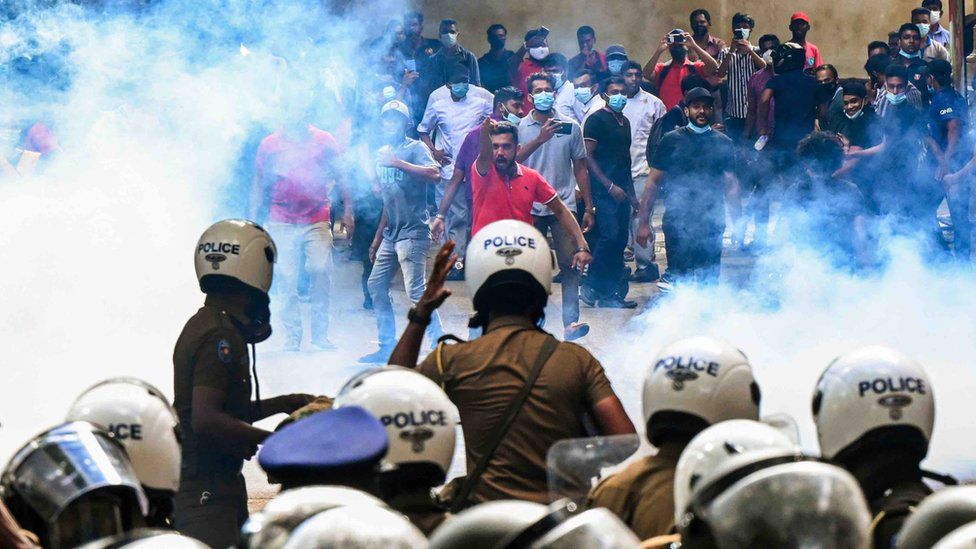:quality(75)/cloudfront-us-east-1.images.arcpublishing.com/elcomercio/GE3TCMJNGEYC2MJYKQYDAORRG4.jpg)
The high cost of living is bringing people to the streets to protest, especially against the alarming increase in prices of basic products.
The BBC has mapped all reported fuel price hike demonstrations since January 2021, and found a large increase in protests so far this year.
LOOK: How is the “green card” with which Germany will facilitate the entry into the country and the search for employment for non-European citizens
The price of fuel affects many aspects of daily life: personal travel and transportation of goods, which in turn can drive up the price of food and energy.
All over the world, protesters have called for change. They have demanded that gasoline be made more affordable or permanently available. They have manifested themselves with peaceful protests and with attacks on governments.
Analyzing data on demonstrations around the world, compiled by the Armed Conflict Location and Event Data Project (ACLED), the BBC established that between January and September this year, more than 90 countries and territories They took to the streets to protest the price or availability of fuel.
A third of those countries had not seen any protests in 2021. Spain, for example, had no demonstrations over fuel prices in 2021, but did report 335 individual demonstrations in March this year.
________________________________
Fuel protests from January 1, 2022
*Analysis of BBC data by the Armed Conflict Location and Event Data Project (ACLED)
_______________________________________
No continent has been free from fuel protests in the last nine months.
In Indonesia there have been more than 400 demonstrations over gasoline so far this year, compared to just 19 in 2021.
In Italy, meanwhile, more than 200 have been filed in the first eight months of 2022 compared to just 2 last year. And in Ecuador, a staggering figure of more than 1,000 protests for fuel only in the month of June.
Analyzing the global pattern of protests, Henry Wilkinson, director of intelligence for Dragonfly, a security and intelligence service, says what surprises him is where they occur.
“What is unusual this time is that we are seeing protests in places that are not normally prone to them. The war in Ukraine has had a huge and disproportionate impact. A resolution of the conflict would significantly alleviate the global crisis,” he said.
Is Ukraine the only reason for the price increase?
The answer is no. There are three key reasons driving the rise in global fuel prices.
The first is crude oil: It was cheaper at the start of the coronavirus pandemic, many businesses temporarily closed, and energy demand collapsed. But as life returned to the “new normal” and energy demand increased, suppliers struggled to keep up with demand, and so prices rose.
The second is that the American dollar it is at its highest point against the pound, the euro, the yuan and the yen. The oil used to make gasoline is paid for in US dollars, so a weak local currency against the dollar makes fuel even more expensive.
The third is the conflict between Ukraine and Russia which has led many countries to ban imports of Russian oil and thus increased demand from other producers, leading to higher prices.
From economic to political collapse
Of the 91 countries and territories that have experienced civil unrest over fuel prices, it was Sri Lanka that grabbed international headlines, earlier in the year, after mass protests brought the government to its knees and ultimately toppled the former president. Gotabaja Rajapaksa.
With some of the highest inflation in Asia, Sri Lankans still face a cost of living crisis as the price of fuel, food and medicine continues to rise.

Wimala Dissanayaka, 48, a vegetable vendor in an upper-class suburb of Colombo, the Sri Lankan capital, says her family is now living hand to mouth.
“Prices of everything have skyrocketed. Our cost of living is going up, but our income hasn’t changed.
“I have three children andBus fares have increased so drastically which now costs 100 rupees (US$0.27) per child to go to school. So, it’s 600 rupees ($1.65) for the three of them every day.”
Wimala says she can no longer afford to fill her small truck with gasoline to take her produce to and from the market. Instead, he has to make do with public transportation or share forklifts with other vendors.
“Prices are very expensive, my clients don’t want to spend a lot. People who used to buy 500 grams or a kilo of vegetables now order 100 grams or 250 grams. And those who used to come by car or motorcycle now come walking or using a push bike.”
no end in sight
As governments around the world struggle to find solutions to their countries’ economic crises, protests over food and fuel continue. But for some, it comes at a high cost.
In the last nine months, according to original BBC research, more than 80 people have lost their lives due to protests over fuel costs. Including protesters from Argentina, Ecuador, Guinea, Haiti, Kazakhstan, Panama, Peru, South Africa and Sierra Leone.
Source: Elcomercio
I, Ronald Payne, am a journalist and author who dedicated his life to telling the stories that need to be said. I have over 7 years of experience as a reporter and editor, covering everything from politics to business to crime.






